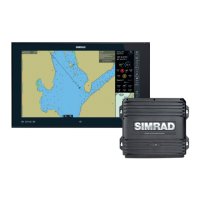Datum transformation
This function is used for converting position information from the active dataset format to a
selected target data format.
Enter latitude and longitude, and select the Forward or Inverse buttons to convert the
position to the selected format.
Manually calculating vessel position
When no GPS is available, the Lines Of Position function (LOP) can be used to calculate your
vessel's position.
The LOPs can be positioned based on known bearing and/or on distance to the selected
objects. The following guidelines apply:
• Two bearing LOPs or 2 distance LOPs will give you an inaccurate position
• Three bearing LOPs give an accurate position if the length of the line from the objects to
the crossing point is less than 0.5 NM
• A combination of 1 bearing LOP and 1 distance LOP gives an accurate position
The system will automatically calculate an estimated position based on the plotted LOP’s.
You can use this information to update the own ship position during dead reckoning
operation.
In the example and illustrations below two bearing LOPs are used to calculate the position.
1. Select Manual observation from the Tools menu to display the manual observation menu
2. Select the empty Latitude field in the Observation points table
3. -
The object is labelled with P1 and an observation object symbol, and the object's
coordinates are listed in the Observation points table
Move the cursor to the first observation point in the chart and press the left cursor button
- A second empty row is added to the Observation points table
4. Double-click any of the observation point fields if you want to manually edit the position
5. Select the identification of the equipment used to measure bearing to the observation
point, and enter the bearing to the observation point
- The first bearing LOP is drawn in the chart based on the input values
6. Repeat step 2, 3, 4 and 5 to position the second observation point (P2)
-
The second LOP is drawn in the chart based on the input values
- Previously taken measurements are automatically corrected according to the distance
own ship traveled between the measurements
Tools for safe navigation | E50xx ECDIS Operator Manual
35

